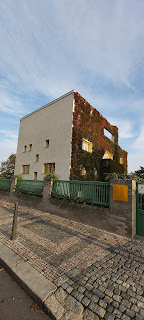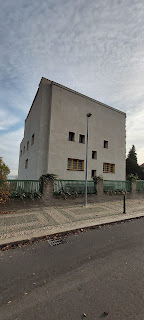The author attempts to establish relationship between philosophy and modern architecture, critically examining the avant-garde endeavors to the social and political manifestation of metropolitan set up. It is an outstanding theoretical plunge into scholastic and polemics of most complex debate on aesthetic-philosophical nature of architectural theory. The author has audaciously challenged the metaphorical thread between architecture and philosophy that has prevailed in intellectual tradition of architectural theory and urbansim.
The three chapters navigates through the authors philosophical trajectory, from Marxian trending to German Urban Sociologist tradition, along with Adolf Loos work and other prominent architectural events. The first chapter is dedicated to artistic representation leading to Loos's Architecture through the argument in " The Dialectics of the Negative and the Metropolis" The Nihilistic position is arising from the tragic eschew of negativity of metropolis, amounting to language of contradiction and sign of alienation of its Architecture. The second chapter on "Loos and his Contemporaries" attempts to frame Loos's architecture being anti-expressive, dismissal, anti-synthetical and un-compositional.
" That artistic choice is searching for neither salvation nor consolation nor escape: the great, tragic form of the artists mentioned by Cacciari can do nothing but be analogus with the negativity of the metropolis. They describe obsessively, present the hard lines of alienation in the most literal senseof the term, alius, other, always different, never coincident with anything, never reconciled with a supposed origin or nature" (Introduction, xxxi).
The Loos's attack on ornament perhaps has nothing to do with stylistic attack but rather emanates from the position of being metropolitan critic and logic. The utopia and artistic representation often are positioned in alignment of capital and driven by metropolitan logic. Such positions are ambiguous and hinged on "unresolved dialectics". Similarly the Otto Wagner releases the idea of city as an image of community, is an attempt to liberate metropolis form the vampire of speculation through artistic form. Perhaps he could reintegrate the ideology of werkbund, and Viennese secession, which is nihilistic in nature.
The second chapter on "Loosian Dialectics" & " Loos and his Angels" begins it argument with critic on functional architecture. The use value in capitalist sense can not have quality to manifest. Every teleological argument is ornamental in nature because it can not be represented due to its inability to surpass its functional value. " if handicraft is "left alone or uncontaminated with the idea of architecture, will naturally express the historic tendency towards its value". But if handicraft value is mystified and subjected to poetic subjectivity or object of exchange value, then it will tend towards the ornamentation. The artistic act of representation as about gratification of ego, necessarily comes to be destined for teleological end. Similarly, the Loos's idea on ornamentation and crime is not an act of de-materialization, rather an representation of an architectonic thought.
The authors brings in variety of argument in the sense of historiography and also cutting across the disciplines, and making un-ventured connections. This book is a must reading for those who are not content with the normative format of architectural criticism and has desire to expand the intellectual debate on architectural trending and its rationale.











No comments:
Post a Comment